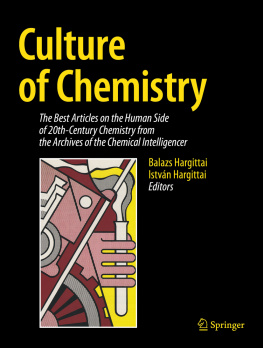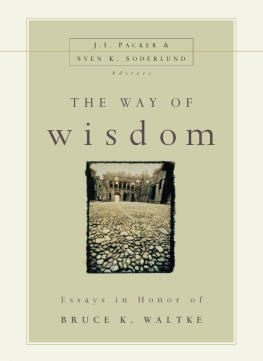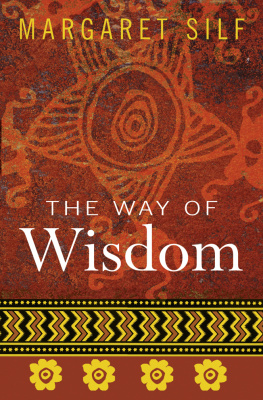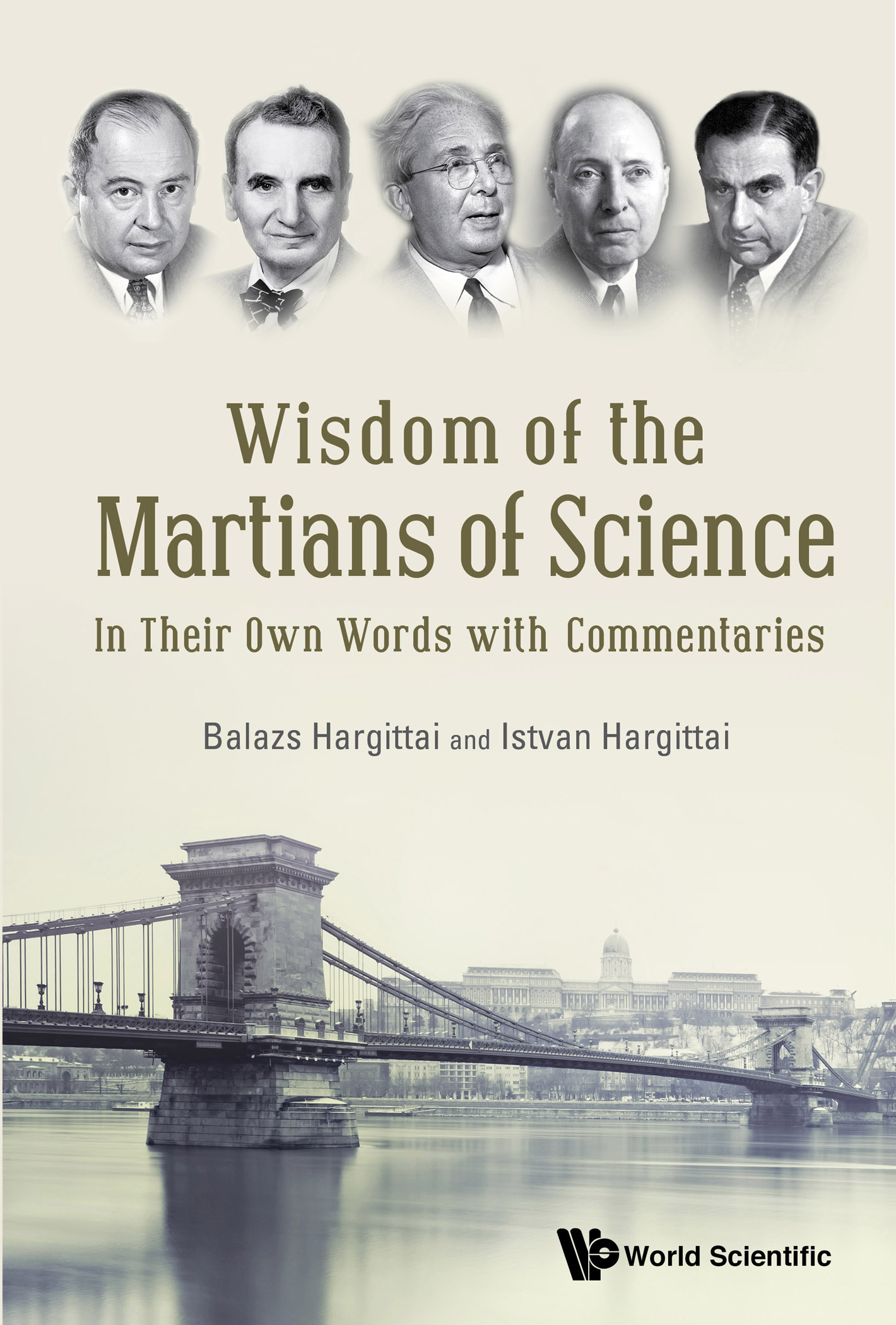Contents
Pagebreaks of the print version
Wisdom of the
Martians of Science
In Their Own Words with Commentaries
Also by the Authors
Istvn Hargittai and Magdolna Hargittai, Budapest Scientific: A Guidebook (Oxford University Press, 2015)
Balazs Hargittai, Magdolna Hargittai, and Istvn Hargittai, Great Minds: Reflections of 111 Top Scientists (Oxford University Press, 2014)
Istvn Hargittai, Buried Glory: Portraits of Soviet Scientists (Oxford University Press, 2013)
Istvn Hargittai, Drive and Curiosity: What Fuels the Passion for Science (Prometheus, 2011)
Istvn Hargittai, Judging Edward Teller: A Closer Look at One of the Most Influential Scientists of the Twentieth Century (Prometheus, 2010)
Magdolna Hargittai and Istvn Hargittai, Symmetry through the Eyes of a Chemist, 3rd Edition (Springer, 2009; 2010)
Magdolna Hargittai and Istvn Hargittai, Visual Symmetry (World Scientific, 2009)
Istvn Hargittai, The DNA Doctor: Candid Conversations with James D. Watson (World Scientific, 2007)
Istvn Hargittai, The Martians of Science: Five Physicists Who Changed the Twentieth Century (Oxford University Press, 2006; 2008)
Istvn Hargittai, Our Lives: Encounters of a Scientist (Akadmiai Kiad, 2004)
Istvn Hargittai, The Road to Stockholm: Nobel Prizes, Science, and Scientists (Oxford University Press, 2002; 2003)
Balazs Hargittai, Istvn Hargittai, and Magdolna Hargittai, Candid Science IVI: Conversations with Famous Scientists (Imperial College Press, 20002006)
Istvn Hargittai and Magdolna Hargittai, In Our Own Image: Personal Symmetry in Discovery (Plenum/Kluwer, 2000; Springer, 2012)
Istvn Hargittai and Magdolna Hargittai, Symmetry: A Unifying Concept (Shelter Publications, 1994)
R. J. Gillespie and Istvn Hargittai, The VSEPR Model of Molecular Geometry (Allyn & Bacon, 1991; Dover Publications, 2012)
Balazs Hargittai and Istvn Hargittai
Wisdom of the
Martians of Science
In Their Own Words with Commentaries


Published by
World Scientific Publishing Co. Pte. Ltd.
5 Toh Tuck Link, Singapore 596224
USA office: 27 Warren Street, Suite 401-402, Hackensack, NJ 07601
UK office: 57 Shelton Street, Covent Garden, London WC2H 9HE
Library of Congress Cataloging-in-Publication Data
Names: Hargittai, Balazs. | Hargittai, Istvn.
Title: Wisdom of the Martians of science : in their own words with commentaries / by Balazs Hargittai and Istvn Hargittai.
Description: New Jersey : World Scientific, [2016] | Includes bibliographical references and index.
Identifiers: LCCN 2015033823| ISBN 9789814723800 (hard cover : alk. paper)
ISBN 9789814723817 (pbk : alk. paper)
Subjects: LCSH: Scientists--Biography.
Classification: LCC Q141 .H26275 2016 | DDC 509.2/2--dc23
LC record available at http://lccn.loc.gov/2015033823
British Library Cataloguing-in-Publication Data
A catalogue record for this book is available from the British Library.
Title page photo: John von Neumann (courtesy of Marina von Neumann Whitman)
Copyright 2016 by Balazs Hargittai and Istvn Hargittai
Printed in Singapore
Let us now praise famous men
Wisdom of Sirach 44:1
We dedicate this book to the memory of Jewish men and women in Hungary
whose higher education and employment in academia was prevented during the anti-Semitic Horthy regime, 19201944;
whom the anti-Semitic laws enacted by the Hungarian Parliament persecuted, humiliated, discriminated against, and robbed;
who were tortured and murdered in slave labor camps, in the ghettoes, in German concentration camps, and on the banks of the Danube, by the State authorities, Gendarmes and Army personnel, and by the German and Hungarian Nazis.
Lest we forget in Budapest, 20142015
Preface
The five Jewish-Hungarian-American scientistsknown as the Martians of Sciencedistinguished themselves with seminal contributions to fundamental science. They made similarly seminal contributions to the defense of their adopted country, the United States, and the Free World during World War II and the ensuing Cold War. Von Neumann has been known as the father of the modern computer; Theodore von Krmn as the scientist behind the US Air Force; Leo Szilard as the initiator of nuclear weapons; the Nobel laureate Eugene P. Wigner as the worlds first nuclear engineer; and the controversial Edward Teller as the father of the hydrogen bomb.
They were geniuses and/or great scientists. Genius in science may be the one who makes a discovery by connecting seemingly unrelated observations and great scientists may be those who know everything there is to know in a certain field. Whether the Martians were either or both, they were arguably wise men, if wisdom means accumulated knowledge and experience from which others can learn and benefit.
The Martians wisdom is less known than their discoveries, and our aim is to exhibit it by sampling their relevant statements and put them into context where this is warranted. Our book provides a glimpse into their thinking, which we find instructive and entertaining. Instructive, because while it cannot be learned how to become a genius, there is a chance that wisdom can be acquired. Entertaining, because these men were witty and even if we cannot always agree with what they say, they were never boring.
We chose von Neumann for our leading individual because his impact through his contributions to the development of the modern computer has reached unprecedented breadth even in our every-day lives and activities.
The interest in our previous books, The Martians of Science,
The five scientists presented here were strange men with distinctive individual traits. They shared similar backgrounds of upper-middle-class Jewish-Hungarian families in Budapest; emigration from their anti-Semitic homeland to the democratic Weimar Germany; and their ultimate emigration to the United States where they finally found their home.
They were willing to risk their impressive careers in science by devoting themselves to the defense of their new home country, democracy, the Free World, and ultimately, the future of humankind. This is what makes them a group regardless of their age differences and the diversity of their politics. The Martians label originated from a joke that has been around in a number of variations. The essence was that during the Manhattan Project someone noted the conspicuous number of smart Hungarian participants in the project. Someone else suggested that they all came from the planet Mars, but to disguise their origin, they spoke Hungarian. The validity of the anecdote stemmed in part from the strange mother tongue of these scientists that left its imprint as a characteristic accent. This label is fine to use as a shorthand notation though it has also been misused as a euphemistic expression to mask their roots.
The backbone of the book is the direct quotes from the Martians. There are also some quotes from others, and there are our commentaries when we deemed them warranted. The structure of the book is simple; following the Introduction, we grouped the material by these five individuals with topical subdivisions for each. Occasional cross-references demonstrate contrast or agreement. One such example was the evaluation of fallout from nuclear tests by von Neumann and Teller, and another was a discussion of the security requirements versus scientific ability for classified research. The topical subdivisions show some variations from chapter to chapter according to the peculiarities of the material collected for each individual. The Index facilitates the utility of this structure.















